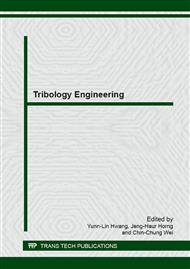p.120
p.125
p.130
p.135
p.141
p.147
p.152
p.162
p.168
The Influence of Velocity Variation on the Adhesive Contact Behavior and the Deformation of Substrate Based on Molecular Dynamics Method
Abstract:
The contact behavior between indenter and single crystal copper substrate is performed to investigate based on EAM and Morse potentials and Verlet algorithm. Effects of different velocities on the contact behavior and substrate deformation are compared and analyzed. The results show that the single crystal copper material’s resist deformation level is limited by low velocity, and more dislocated atoms were accumulated under the direction of indenter moving in higher indenting velocity. During sliding process, lager chip volume is produced in front of the indenter as the sliding speed or sliding distance increases. The dislocated band in basis lies at the angle of 45 degrees with the direction of indenter moving in indenting and sliding process. Furthermore, the contact force, friction force and normal force increase with the rising of speed. On the contrary, the friction coefficient decrease gradually with higher sliding speed.
Info:
Periodical:
Pages:
141-146
Citation:
Online since:
April 2015
Authors:
Price:
Сopyright:
© 2015 Trans Tech Publications Ltd. All Rights Reserved
Share:
Citation:


